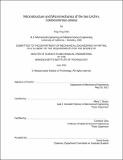| dc.contributor.advisor | Mary C. Boyce and Christine Ortiz. | en_US |
| dc.contributor.author | Chen, Ting-Ting, S.M. Massachusetts Institute of Technology | en_US |
| dc.contributor.other | Massachusetts Institute of Technology. Dept. of Mechanical Engineering. | en_US |
| dc.date.accessioned | 2011-12-05T15:42:33Z | |
| dc.date.available | 2011-12-05T15:42:33Z | |
| dc.date.issued | 2011 | en_US |
| dc.identifier.uri | http://hdl.handle.net/1721.1/67360 | |
| dc.description | Thesis (S.M.)--Massachusetts Institute of Technology, Dept. of Mechanical Engineering, 2011. | en_US |
| dc.description | This electronic version was submitted by the student author. The certified thesis is available in the Institute Archives and Special Collections. | en_US |
| dc.description | "June 2011." Cataloged from student-submitted PDF version of thesis. | en_US |
| dc.description | Includes bibliographical references (p. 128-132). | en_US |
| dc.description.abstract | The purpose of this research is to study the porous microstructure and the micromechanics of the exoskeletal armor of the helmet urchin, Colobocentrotus atratus. Its unusual reduction in spines forms a smooth tiling of millimeter-sized, flattened polygonal protective aboral spines. Each aboral spine articulates with the underlying test via a ball-and-socket joint and the microstructure of each aboral spine is a porous network of single-crystal magnesium-doped calcite with a few percent of intercalated organic. Methods of microstructural characterization and simulation were developed through the investigation of the urchin's microstructure and the finite element model. With the high resolution scans from X-ray microcomputed tomography at the Advanced Photon Source at Argonne National Laboratory, Beamline 2BM, visualization and characterization of a complex porous network in three-dimensions was possible, providing a more quantitative insight into the geometry of the microstructure not characterized before in urchin biology literature. The galleried stereom of the individual spines were found to possess a gradient in volume fraction with distance from the socket ranging from 90% at the ball-and-socket joint to 50% at the outer surface. The axial direction of the galleried structure radiates outwardly from the socket and terminated perpendicular to the outer surface of the aboral spine. Additionally, with the microcomputed tomography results, an efficient and more accurate finite element model of an entire aboral spine along with the microstructural properties was created. The galleried mesh (average pore size ~ 15 microns) was modeled using three-dimensional elastic finite element analysis that consisted of a microstructurally-based parametric representative volume element with periodic boundary conditions. Various loading configurations were simulated to obtain anisotropic stiffness tensors and resulted in an orthotropic effective mechanical behavior with the stiffness in the plane transverse to the long axis of the galleried microstructure (E1, E2) approximately half the stiffness in the axial direction (E3). With parametric simulations, E3 was found to decrease linearly from 0.87 of the solid elastic modulus (Es) to 0.34 of Es as the volume fraction decreases from 0.88 to 0.46. In the transverse direction, E1 and E2 also decrease linearly from 0.49 of Es to 0.18 of Es within the same range of volume fraction. Spatial gradients in density were also modeled, corresponding to the gradient in porosity in the aboral spine. From simulation of blunt indentation by both a conical indenter and flat plate indenter, the graded porosity of the microstructure exhibits an expected lower overall stiffness and lower stress state than the solid material, but also serves to increase the strains near the exterior surface of the aboral spine while reducing the strains near the joint. This open-pore structure and trabeculae alignment results in a directional strengthening due to inhomogeneous deformations in the porous structure and provides resistance against blunt impacts and containment of penetration into the surface of the aboral spine. | en_US |
| dc.description.statementofresponsibility | by Ting-Ting Chen. | en_US |
| dc.format.extent | 132 p. | en_US |
| dc.language.iso | eng | en_US |
| dc.publisher | Massachusetts Institute of Technology | en_US |
| dc.rights | M.I.T. theses are protected by
copyright. They may be viewed from this source for any purpose, but
reproduction or distribution in any format is prohibited without written
permission. See provided URL for inquiries about permission. | en_US |
| dc.rights.uri | http://dspace.mit.edu/handle/1721.1/7582 | en_US |
| dc.subject | Mechanical Engineering. | en_US |
| dc.title | Microstructure and micromechanics of the sea urchin, Colobocentrotus atratus | en_US |
| dc.type | Thesis | en_US |
| dc.description.degree | S.M. | en_US |
| dc.contributor.department | Massachusetts Institute of Technology. Department of Mechanical Engineering | |
| dc.identifier.oclc | 765399844 | en_US |
